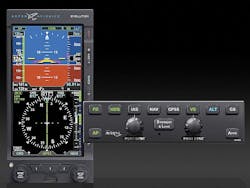Avidyne gets Brazilian validation of DFC90 digital autopilot in Cessna 182 when interfaced with Aspen flight display
LINCOLN, Mass., 2 May 2013. Avidyne Corp. in Lincoln, Mass., has received validation from the national aviation agency of Brazil for the Avidyne DFC90 digital autopilot in Cessna 182-single-engine general-aviation aircraft when interfaced with the Evolution Pro primary flight display (PFD) from Aspen Avionics in Albuquerque, N.M.
Validation approval came from the Agência Nacional De Aviação Civil -Brasil (ANAC). This DFC90 autopilot validation includes 16 models of the Cessna 182 Skylane series including the 182E, 182F, 182G, 182H, 182J, 182K, 182L, 182M, 182N, R182N, 182P, 182Q, 182R, 182S, 182T, and the R182.
Aspen holds an approved model list supplemental type certificate (AML-STC) and ANAC approval for their Evolution Pro PFD on a wide range of aircraft including these Cessna 182 models.
The DFC90 digital autopilot system adds performance and safety benefits including airspeed hold (IAS), envelope protection (EP) and full-time envelope alerting (EA), which prevent stalls and overspeeds, as well as monitoring and alerting when the autopilot is off.
The straight & level capability provides one-button recovery from unusual attitudes. The DFC90 was designed as a plug-and-play replacement for existing STEC55X autopilot systems.
The DFC90 can use the existing 55X mounting tray, servos, and much of the wiring. While not plug and play, STEC30/50/60-2/65 series autopilots may also be replaced by a DFC90 under this STC, making use of existing STEC servos and brackets.
The Aspen Pro PFD provides attitude inputs to the DFC90 from its integrated Air Data and Attitude/Heading Reference Sensor (ADAHRS), while presenting the pilot with autopilot mode annunciations and alerts right on the primary flight instrument.
In addition to pitch and roll inputs, the Aspen Pro PFD also provides heading select, altitude preselect, indicated airspeed select, and vertical speed select inputs to the DFC90. The Aspen Pro PFD also has an optional synthetic vision have for added situational awareness and safety.
For more information contact Avidyne online at www.avidyne.com, or Aspen Avionics at www.aspenavionics.com.
About the Author
John Keller
Editor-in-Chief
John Keller is the Editor-in-Chief, Military & Aerospace Electronics Magazine--provides extensive coverage and analysis of enabling electronics and optoelectronic technologies in military, space and commercial aviation applications. John has been a member of the Military & Aerospace Electronics staff since 1989 and chief editor since 1995.
